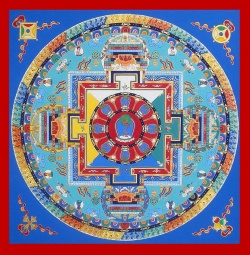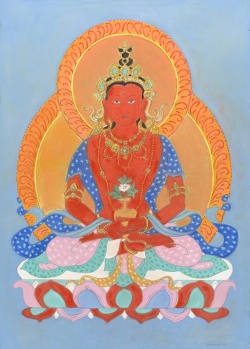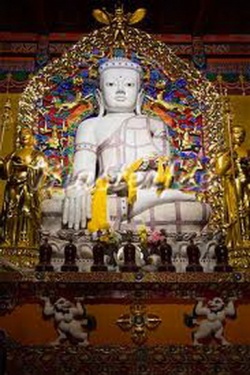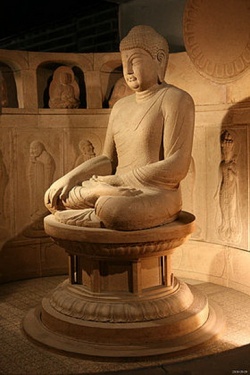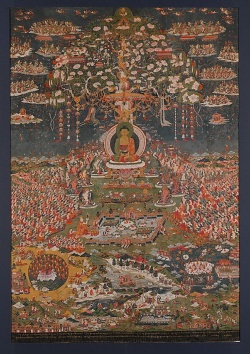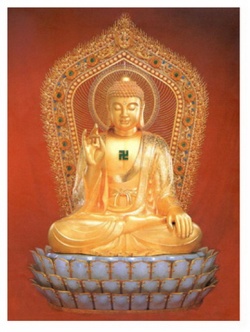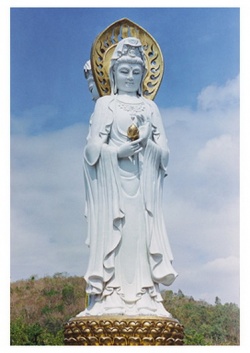Difference between revisions of "Śūraṅgama Sūtra"
(Created page with "<poem> The Śūraṅgama Sūtra (traditional {{Wiki|Chinese}}: 大佛頂首楞嚴經; pinyin: Dà Fódǐng Shǒuléngyán Jīng) is a Mahāyāna Buddhist s...") |
|||
| Line 1: | Line 1: | ||
| + | [[File:Amitayus-mandala-ie.jpg|thumb|250px|]] | ||
<poem> | <poem> | ||
| − | The [[Śūraṅgama Sūtra]] ([[traditional]] {{Wiki|Chinese}}: 大佛頂首楞嚴經; pinyin: Dà Fódǐng Shǒuléngyán Jīng) is a [[Mahāyāna]] [[Buddhist]] [[sūtra]], and has been especially influential in the [[Chán]] school of [[Chinese Buddhism]]. | + | The [[Śūraṅgama Sūtra]] ([[traditional]] {{Wiki|Chinese}}: [[大佛頂首楞嚴經]]; pinyin: [[Dà Fódǐng Shǒuléngyán Jīng]]) is a [[Mahāyāna]] [[Buddhist]] [[sūtra]], and has been especially influential in the [[Chán]] school of [[Chinese Buddhism]]. |
| − | + | [[File:025Amitayus.jpg|thumb|250px|]] | |
{{Wiki|Etymology}} | {{Wiki|Etymology}} | ||
| − | The original [[Sanskrit]] version of [[Shurangama Sutra]] have not been found yet. Nobody really know what is its [[Sanskrit]] [[name]]. The complete title preserved in {{Wiki|Chinese}} version, is {{Wiki|Chinese}}: 大佛頂如來密因修證了義諸菩薩萬行首楞嚴經, and may be translated as | + | The original [[Sanskrit]] version of [[Shurangama Sutra]] have not been found yet. Nobody really know what is its [[Sanskrit]] [[name]]. The complete title preserved in {{Wiki|Chinese}} version, is {{Wiki|Chinese}}: [[大佛頂如來密因修證了義諸菩薩萬行首楞嚴經]], and may be translated as |
| − | + | [[File:Ees r3r.jpg|thumb|250px|]] | |
The [[Sūtra]] on the [[Śūraṅgama]] [[Mantra]] Spoken from above the {{Wiki|Crown}} of the Great [[Buddha's]] {{Wiki|Head}}, and on the Hidden Basis of the [[Tathagata's]] Myriad [[Bodhisattva]] Practices Leading to Their Verification of the [[Ultimate Truth]]. | The [[Sūtra]] on the [[Śūraṅgama]] [[Mantra]] Spoken from above the {{Wiki|Crown}} of the Great [[Buddha's]] {{Wiki|Head}}, and on the Hidden Basis of the [[Tathagata's]] Myriad [[Bodhisattva]] Practices Leading to Their Verification of the [[Ultimate Truth]]. | ||
| − | + | [[File:2 odel-01.jpg|thumb|250px|]] | |
| − | And in old {{Wiki|Chinese}} version, a small footnote give us its another [[name]] which is {{Wiki|Chinese}}: 中印度那爛陀大道場經, 於灌頂部錄出別行. | + | And in old {{Wiki|Chinese}} version, a small footnote give us its another [[name]] which is {{Wiki|Chinese}}: [[中印度那爛陀大道場經]], [[於灌頂部錄出別行]]. |
| − | + | [[File:2io1 500.jpg|thumb|250px|]] | |
| − | In [[Chinese Buddhism]], it could be shorted as {{Wiki|Chinese}}: 首楞嚴經 or {{Wiki|Chinese}}: 楞嚴經. That [[name]] is similar with [[Shurangama]] [[Samadhi Sutra]] ([[traditional]] {{Wiki|Chinese}}: 首楞嚴三昧經) in {{Wiki|Chinese}}, so Joseph Edkins translated it to surangama-samadhi-sutra in English version. Then Charles Luk translated it to [[Shurangama Sutra]]. [[Śūraṅgama]] roughly means "{{Wiki|indestructible}}." The [[word]] is composed of Śūraṅ (great, absolutely), with Gama (durable, {{Wiki|solid}}). | + | In [[Chinese Buddhism]], it could be shorted as {{Wiki|Chinese}}: [[首楞嚴經]] or {{Wiki|Chinese}}: [[楞嚴經]]. That [[name]] is similar with [[Shurangama]] [[Samadhi Sutra]] ([[traditional]] {{Wiki|Chinese}}: [[首楞嚴三昧經]]) in {{Wiki|Chinese}}, so Joseph Edkins translated it to [[surangama-samadhi-sutra]] in English version. Then Charles Luk translated it to [[Shurangama Sutra]]. [[Śūraṅgama]] roughly means "{{Wiki|indestructible}}." The [[word]] is composed of [[Śūraṅ]] ([[great]], [[absolutely]]), with [[Gama]] ([[durable]], {{Wiki|solid}}). |
Title | Title | ||
| − | + | [[File:Fj4.jpg|thumb|250px|]] | |
{{Wiki|East Asian}} title include: | {{Wiki|East Asian}} title include: | ||
| − | {{Wiki|Traditional Chinese}}: 大佛頂如來密因修證了義諸菩薩萬行首楞嚴經 | + | {{Wiki|Traditional Chinese}}: [[大佛頂如來密因修證了義諸菩薩萬行首楞嚴經]] |
| − | Simplified {{Wiki|Chinese}}: 大佛顶如来密因修证了义诸菩萨万行首楞严经 | + | Simplified {{Wiki|Chinese}}: [[大佛顶如来密因修证了义诸菩萨万行首楞严经]] |
| − | {{Wiki|Chinese}} Pinyin: dà fódǐng rúlái mìyīn xiūzhèng liǎoyì zhū púsà wànxíng shǒuléngyán jīng | + | {{Wiki|Chinese}} Pinyin: [[dà fódǐng rúlái mìyīn xiūzhèng liǎoyì zhū púsà wànxíng shǒuléngyán jīng]] |
| − | [[Korean]]: 대불정여래밀인수증료의제보살만행수릉엄경 | + | [[Korean]]: [[대불정여래밀인수증료의제보살만행수릉엄경]] |
| − | [[Vietnamese]]: Đại Phật đỉnh Như Lai mật nhân tu chứng liễu nghĩa chư Bồ Tát vạn hạnh thủ-lăng-nghiêm kinh | + | [[Vietnamese]]: [[Đại Phật đỉnh Như Lai mật nhân tu chứng liễu nghĩa chư Bồ Tát vạn hạnh thủ-lăng-nghiêm kinh]] |
| − | + | [[File:Fj3.jpg|thumb|250px|]] | |
| − | It is also known in {{Wiki|Chinese}} by shorter versions of the title such as dà fódǐng shǒuléngyán jīng (大佛頂首楞嚴經) or simply and more commonly léngyán jīng (楞嚴經). | + | It is also known in {{Wiki|Chinese}} by shorter versions of the title such as [[dà fódǐng shǒuléngyán jīng]] ([[大佛頂首楞嚴經]]) or simply and more commonly [[léngyán jīng]] ([[楞嚴經]]). |
{{Wiki|History}} | {{Wiki|History}} | ||
Authorship | Authorship | ||
| − | [[Shurangama Sutra]] did not record an official catalogue. The first one who gave an account of the [[Śūraṅgama Sūtra]] was Zhi-sheng ({{Wiki|Chinese}}: 智昇), a [[monk]] of the {{Wiki|Tang Dynasty}}. Zhi-sheng said this [[book]] was brought back from Guangxi to Luoyang during the Kaiyuan {{Wiki|era}}. He gave two different accounts in two different [[books]], which were published in 730 CE. | + | [[Shurangama Sutra]] did not record an official catalogue. The first one who gave an account of the [[Śūraṅgama Sūtra]] was [[Zhi-sheng]] ({{Wiki|Chinese}}: [[智昇]]), a [[monk]] of the {{Wiki|Tang Dynasty}}. [[Zhi-sheng]] said this [[book]] was brought back from Guangxi to Luoyang during the Kaiyuan {{Wiki|era}}. He gave two different accounts in two different [[books]], which were published in 730 CE. |
| − | According to the first account, in his [[book]] [[Buddhist texts]] catalogue of Kaiyuan era(Chinese: 開元釋教錄), the [[Śūraṅgama Sūtra]] was translated about in 713 CE by a [[monk]] Huai-Di ({{Wiki|Chinese}}: 懷迪) with an unnamed [[Indian]] [[monk]]. | + | According to the first account, in his [[book]] [[Buddhist texts]] catalogue of Kaiyuan era(Chinese: 開元釋教錄), the [[Śūraṅgama Sūtra]] was translated about in 713 CE by a [[monk]] [[Huai-Di]] ({{Wiki|Chinese}}: [[懷迪]]) with an unnamed [[Indian]] [[monk]]. |
| − | According to the second account, in his later [[book]] The story about this translation of [[Buddhist scriptures]] mural (續古今譯經圖記), the [[Śūraṅgama Sūtra]] was translated in May 705 CE by [[Śramaṇa]] | + | According to the second account, in his later [[book]] The story about this translation of [[Buddhist scriptures]] mural (續古今譯經圖記), the [[Śūraṅgama Sūtra]] was translated in May 705 CE by [[Śramaṇa Pāramiti]] from {{Wiki|Central}} [[India]], who came to [[China]] and brought the text to the province of Guangzhou. The text was then polished and edited by {{Wiki|Empress}} {{Wiki|Wu Zetian}}'s former minister, court regulator, and state censor [[Fang Yong]](Chinese: [[房融]]) of Qingho. The translation was reviewed by [[Śramaṇa]] [[Meghaśikha]] from [[Oḍḍiyāna]], and certified by [[Śramaṇa]] [[Huai-di]](Chinese: [[懷迪]]) of [[Nanlou]] [[Monastery]] ([[南樓寺]]) on {{Wiki|Mount Luofu}} (羅浮山). |
Zhi-sheng didn't explain why he wrote two different record, but at the end of The story about this translation of [[Buddhist scriptures]] mural (續古今譯經圖記) he left a small comment, recommending readers the record at Buddish [[Book]] catalogue of Kaiyuan {{Wiki|era}} is better than The story about this translation of [[Buddhist scriptures]] mural (續古今譯經圖記). | Zhi-sheng didn't explain why he wrote two different record, but at the end of The story about this translation of [[Buddhist scriptures]] mural (續古今譯經圖記) he left a small comment, recommending readers the record at Buddish [[Book]] catalogue of Kaiyuan {{Wiki|era}} is better than The story about this translation of [[Buddhist scriptures]] mural (續古今譯經圖記). | ||
| Line 41: | Line 42: | ||
Translations | Translations | ||
| − | The [[Surangama Sutra]] has been translated from {{Wiki|Chinese}} into [[Tibetan]] under the command of the Qianlong | + | The [[Surangama Sutra]] has been translated from {{Wiki|Chinese}} into [[Tibetan]] under the command of the {{Wiki|Qianlong Emperor}}. The [[Changkya Khutukhtu]] supervised the translation of the [[Surangama Sutra]] from {{Wiki|Chinese}} to {{Wiki|Manchu}} [[language]]. The text was also translated into {{Wiki|Mongolian}} and [[Tibetan]]. |
There are two English translations: | There are two English translations: | ||
Charles Luk, 1967, [[Shurangama Sutra]] | Charles Luk, 1967, [[Shurangama Sutra]] | ||
| − | [[Buddhist]] Translation {{Wiki|Society}}, 2009, with a commentary by Hsüan Hua | + | [[Buddhist]] Translation {{Wiki|Society}}, 2009, with a commentary by [[Hsüan Hua]] |
Teachings | Teachings | ||
| Line 59: | Line 60: | ||
[[Śūraṅgama]] [[Samādhi]] | [[Śūraṅgama]] [[Samādhi]] | ||
| − | The [[Śūraṅgama Sūtra]] teaches about the [[Śūraṅgama]] [[Samādhi]], which is associated with [[complete enlightenment]] and [[Buddhahood]]. This [[samādhi]] is also featured extensively in the [[Śūraṅgama]] [[Samādhi]] [[Sūtra]], another [[Mahayana]] text. It is equally praised in the [[Mahāyāna]] [[Mahāparinirvāṇa Sūtra]], where it is explained by the [[Buddha]] that this [[samādhi]] is the [[essence]] of the nature of the [[Buddha]] and is indeed the "mother of all [[Buddhas]]." The [[Buddha]] also comments that the [[Śūraṅgama]] [[Samādhi]] additionally goes under several other names, specifically [[Prajñāpāramitā]] ("[[Perfection of Wisdom]]"), the [[Vajra]] [[Samādhi]] ("[[Diamond]] [[Samadhi]]"), the Siṃhanāda [[Samādhi]] ("[[Lion's Roar]] [[Samādhi]]"), and the Buddhasvabhava ("[[Buddha-nature]]"). | + | The [[Śūraṅgama Sūtra]] teaches about the [[Śūraṅgama]] [[Samādhi]], which is associated with [[complete enlightenment]] and [[Buddhahood]]. This [[samādhi]] is also featured extensively in the [[Śūraṅgama]] [[Samādhi]] [[Sūtra]], another [[Mahayana]] text. It is equally praised in the [[Mahāyāna]] [[Mahāparinirvāṇa Sūtra]], where it is explained by the [[Buddha]] that this [[samādhi]] is the [[essence]] of the nature of the [[Buddha]] and is indeed the "mother of all [[Buddhas]]." The [[Buddha]] also comments that the [[Śūraṅgama]] [[Samādhi]] additionally goes under several other names, specifically [[Prajñāpāramitā]] ("[[Perfection of Wisdom]]"), the [[Vajra]] [[Samādhi]] ("[[Diamond]] [[Samadhi]]"), the [[Siṃhanāda]] [[Samādhi]] ("[[Lion's Roar]] [[Samādhi]]"), and the [[Buddhasvabhava]] ("[[Buddha-nature]]"). |
White [[Parasol]] {{Wiki|Crown}} [[Dhāraṇī]] | White [[Parasol]] {{Wiki|Crown}} [[Dhāraṇī]] | ||
| − | In addition to the sūtra's contents, the [[Sanskrit]] [[ritual]] [[speech]] contained in it is known in {{Wiki|Chinese}} as the Léngyán Zhòu (楞嚴咒), or [[Shurangama Mantra]]. It is well-known and popularly chanted in {{Wiki|East Asian}} [[Buddhism]]. In [[Sanskrit]], the [[dhāraṇī]] is known as the "Sitātapatra Uṣṇīṣa [[Dhāraṇī]]" (Ch. 大白傘蓋陀羅尼). This is sometimes simplified in English to "White Canopy [[Dhāraṇī]]" or " | + | In addition to the [[sūtra's]] contents, the [[Sanskrit]] [[ritual]] [[speech]] contained in it is known in {{Wiki|Chinese}} as the [[Léngyán Zhòu]] ([[楞嚴咒]]), or [[Shurangama Mantra]]. It is well-known and popularly chanted in {{Wiki|East Asian}} [[Buddhism]]. In [[Sanskrit]], the [[dhāraṇī]] is known as the "[[Sitātapatra Uṣṇīṣa]] [[Dhāraṇī]]" (Ch. 大白傘蓋陀羅尼). This is sometimes simplified in English to "[[White Canopy]] [[Dhāraṇī]]" or "[[White Parasol]] [[Dhāraṇī]]." In [[Tibetan]] [[traditions]], the English is instead sometimes rendered as the "[[White Umbrella]] [[Mantra]]." The [[dhāraṇī]] is extant in three other translations found in the [[Chinese Buddhist canon]] , and is also preserved in [[Sanskrit]] and [[Tibetan]]. |
According to [[Venerable]] [[Hsuan Hua]], the [[dharani]] contains five major divisions, which "control the vast [[demon]] armies of the five [[directions]]": | According to [[Venerable]] [[Hsuan Hua]], the [[dharani]] contains five major divisions, which "control the vast [[demon]] armies of the five [[directions]]": | ||
In the {{Wiki|East}} is the [[Vajra]] Division, hosted by [[Akṣobhya]] [[Buddha]]; | In the {{Wiki|East}} is the [[Vajra]] Division, hosted by [[Akṣobhya]] [[Buddha]]; | ||
| − | In the {{Wiki|south}}, the Jewel-creating Division, hosted by Ratnasaṃbhava [[Buddha]]; | + | In the {{Wiki|south}}, the Jewel-creating Division, hosted by [[Ratnasaṃbhava]] [[Buddha]]; |
In the center, the [[Buddha]] Division, hosted by [[Vairocana]] [[Buddha]]; | In the center, the [[Buddha]] Division, hosted by [[Vairocana]] [[Buddha]]; | ||
In the {{Wiki|West}}, the [[Lotus]] Division, hosted by [[Amitābha]] [[Buddha]]; | In the {{Wiki|West}}, the [[Lotus]] Division, hosted by [[Amitābha]] [[Buddha]]; | ||
| Line 80: | Line 81: | ||
... found reference to 127 {{Wiki|Chinese}} commentaries on the [[Sutra]], quite a few for such a lengthy work, including 59 in the {{Wiki|Ming dynasty}} alone, when it was especially popular ". | ... found reference to 127 {{Wiki|Chinese}} commentaries on the [[Sutra]], quite a few for such a lengthy work, including 59 in the {{Wiki|Ming dynasty}} alone, when it was especially popular ". | ||
| − | Chán-buddhism | + | [[Chán-buddhism]] |
| − | The [[Śūraṅgama Sūtra]] is one of the seminal texts of Chán-buddhism. It was first transmitted by Shenxiu, the original [[sixth patriarch]] and the seminal figure of the [[Northern school]]. It "is connected with the [[enlightenment]] of" Changshui Zixuan from the {{Wiki|Song Dynasty}} and [[Hanshan Deqing]] ([[憨山德清]]) from the {{Wiki|Ming Dynasty}}. | + | The [[Śūraṅgama Sūtra]] is one of the seminal texts of [[Chán]]-[[buddhism]]. It was first transmitted by [[Shenxiu]], the original [[sixth patriarch]] and the seminal figure of the [[Northern school]]. It "is connected with the [[enlightenment]] of" [[Changshui Zixuan]] from the {{Wiki|Song Dynasty}} and [[Hanshan Deqing]] ([[憨山德清]]) from the {{Wiki|Ming Dynasty}}. |
The [[Śūraṅgama Sūtra]] is {{Wiki|being}} cited in case 94 of the [[Blue]] Cliff Record: | The [[Śūraṅgama Sūtra]] is {{Wiki|being}} cited in case 94 of the [[Blue]] Cliff Record: | ||
| Line 92: | Line 93: | ||
This verse has been cited by various [[Buddhas]] and {{Wiki|Ancestors}} alike. Up to this very day, this verse is truly the Bones and Marrow of the [[Buddhas]] and {{Wiki|Ancestors}}. It is the very [[Eye]] of the [[Buddhas]] and {{Wiki|Ancestors}}. As to my [[intention]] in saying so, there are those who say that the ten-fascicle [[Shurangama]] [[Scripture]] is a spurious [[scripture]], whereas others say that it is a genuine [[Scripture]]: both [[views]] have persisted from long in the past down to our very day [...] Even were the [[Scripture]] a spurious one, if [{{Wiki|Ancestors}}] continue to offer its turning, then it is a genuine [[Scripture]] of the [[Buddhas]] and {{Wiki|Ancestors}}, as well as the [[Dharma Wheel]] intimately associated with Them. | This verse has been cited by various [[Buddhas]] and {{Wiki|Ancestors}} alike. Up to this very day, this verse is truly the Bones and Marrow of the [[Buddhas]] and {{Wiki|Ancestors}}. It is the very [[Eye]] of the [[Buddhas]] and {{Wiki|Ancestors}}. As to my [[intention]] in saying so, there are those who say that the ten-fascicle [[Shurangama]] [[Scripture]] is a spurious [[scripture]], whereas others say that it is a genuine [[Scripture]]: both [[views]] have persisted from long in the past down to our very day [...] Even were the [[Scripture]] a spurious one, if [{{Wiki|Ancestors}}] continue to offer its turning, then it is a genuine [[Scripture]] of the [[Buddhas]] and {{Wiki|Ancestors}}, as well as the [[Dharma Wheel]] intimately associated with Them. | ||
| − | The contemporary Chán-master [[Venerable]] Hsu Yun wrote a commentary on the [[Śūraṅgama Sūtra]]. [[Venerable]] [[Hsuan Hua]] was a major {{Wiki|modern}} proponent of the [[Śūraṅgama Sūtra]], which he commented and used in his instructions on protecting and supporting the Proper [[Dharma]]. About the [[Śūraṅgama Sūtra]], he said: | + | The contemporary [[Chán]]-[[master]] [[Venerable]] [[Hsu Yun]] wrote a commentary on the [[Śūraṅgama Sūtra]]. [[Venerable]] [[Hsuan Hua]] was a major {{Wiki|modern}} proponent of the [[Śūraṅgama Sūtra]], which he commented and used in his instructions on protecting and supporting the Proper [[Dharma]]. About the [[Śūraṅgama Sūtra]], he said: |
In [[Buddhism]] all the [[sutras]] are very important, but the [[Śūraṅgama Sūtra]] is most important. Wherever the [[Śūraṅgama Sūtra]] is, the Proper [[Dharma]] abides in the [[world]]. When the [[Śūraṅgama Sūtra]] is gone, that is a sign of the [[Dharma]] Ending Age. In the [[Extinction]] of the [[Dharma]] [[Sutra]] it says that in the [[Dharma]] Ending Age, the [[Śūraṅgama Sūtra]] will become [[extinct]] first. Then gradually the other [[sutras]] will also become [[extinct]]. The [[Śūraṅgama Sūtra]] is the true [[body]] of the [[Buddha]]; the [[śarīra]] ([[relics]]) of the [[Buddha]]; the [[stūpa]] of the [[Buddha]]. | In [[Buddhism]] all the [[sutras]] are very important, but the [[Śūraṅgama Sūtra]] is most important. Wherever the [[Śūraṅgama Sūtra]] is, the Proper [[Dharma]] abides in the [[world]]. When the [[Śūraṅgama Sūtra]] is gone, that is a sign of the [[Dharma]] Ending Age. In the [[Extinction]] of the [[Dharma]] [[Sutra]] it says that in the [[Dharma]] Ending Age, the [[Śūraṅgama Sūtra]] will become [[extinct]] first. Then gradually the other [[sutras]] will also become [[extinct]]. The [[Śūraṅgama Sūtra]] is the true [[body]] of the [[Buddha]]; the [[śarīra]] ([[relics]]) of the [[Buddha]]; the [[stūpa]] of the [[Buddha]]. | ||
</poem> | </poem> | ||
{{W}} | {{W}} | ||
| − | [[Category: | + | [[Category:Shurangama Sutra]] |
Revision as of 08:34, 16 September 2013
The Śūraṅgama Sūtra (traditional Chinese: 大佛頂首楞嚴經; pinyin: Dà Fódǐng Shǒuléngyán Jīng) is a Mahāyāna Buddhist sūtra, and has been especially influential in the Chán school of Chinese Buddhism.
Etymology
The original Sanskrit version of Shurangama Sutra have not been found yet. Nobody really know what is its Sanskrit name. The complete title preserved in Chinese version, is Chinese: 大佛頂如來密因修證了義諸菩薩萬行首楞嚴經, and may be translated as
The Sūtra on the Śūraṅgama Mantra Spoken from above the Crown of the Great Buddha's Head, and on the Hidden Basis of the Tathagata's Myriad Bodhisattva Practices Leading to Their Verification of the Ultimate Truth.
And in old Chinese version, a small footnote give us its another name which is Chinese: 中印度那爛陀大道場經, 於灌頂部錄出別行.
In Chinese Buddhism, it could be shorted as Chinese: 首楞嚴經 or Chinese: 楞嚴經. That name is similar with Shurangama Samadhi Sutra (traditional Chinese: 首楞嚴三昧經) in Chinese, so Joseph Edkins translated it to surangama-samadhi-sutra in English version. Then Charles Luk translated it to Shurangama Sutra. Śūraṅgama roughly means "indestructible." The word is composed of Śūraṅ (great, absolutely), with Gama (durable, solid).
Title
East Asian title include:
Traditional Chinese: 大佛頂如來密因修證了義諸菩薩萬行首楞嚴經
Simplified Chinese: 大佛顶如来密因修证了义诸菩萨万行首楞严经
Chinese Pinyin: dà fódǐng rúlái mìyīn xiūzhèng liǎoyì zhū púsà wànxíng shǒuléngyán jīng
Korean: 대불정여래밀인수증료의제보살만행수릉엄경
Vietnamese: Đại Phật đỉnh Như Lai mật nhân tu chứng liễu nghĩa chư Bồ Tát vạn hạnh thủ-lăng-nghiêm kinh
It is also known in Chinese by shorter versions of the title such as dà fódǐng shǒuléngyán jīng (大佛頂首楞嚴經) or simply and more commonly léngyán jīng (楞嚴經).
History
Authorship
Shurangama Sutra did not record an official catalogue. The first one who gave an account of the Śūraṅgama Sūtra was Zhi-sheng (Chinese: 智昇), a monk of the Tang Dynasty. Zhi-sheng said this book was brought back from Guangxi to Luoyang during the Kaiyuan era. He gave two different accounts in two different books, which were published in 730 CE.
According to the first account, in his book Buddhist texts catalogue of Kaiyuan era(Chinese: 開元釋教錄), the Śūraṅgama Sūtra was translated about in 713 CE by a monk Huai-Di (Chinese: 懷迪) with an unnamed Indian monk.
According to the second account, in his later book The story about this translation of Buddhist scriptures mural (續古今譯經圖記), the Śūraṅgama Sūtra was translated in May 705 CE by Śramaṇa Pāramiti from Central India, who came to China and brought the text to the province of Guangzhou. The text was then polished and edited by Empress Wu Zetian's former minister, court regulator, and state censor Fang Yong(Chinese: 房融) of Qingho. The translation was reviewed by Śramaṇa Meghaśikha from Oḍḍiyāna, and certified by Śramaṇa Huai-di(Chinese: 懷迪) of Nanlou Monastery (南樓寺) on Mount Luofu (羅浮山).
Zhi-sheng didn't explain why he wrote two different record, but at the end of The story about this translation of Buddhist scriptures mural (續古今譯經圖記) he left a small comment, recommending readers the record at Buddish Book catalogue of Kaiyuan era is better than The story about this translation of Buddhist scriptures mural (續古今譯經圖記).
Since the Tang Dynasty there has been debate in East Asian Buddhism whether the Shurangama Sutra is a forgery or not.[who?] Dispute arose in 8th century in Japan, so Emperor Kōnin sent a monk to china, asking whether this book is forgery or not. His Chinese teacher told him that this is was forged by Fang Yong. Zhu Xi, a 12th-century Neo-confucian who was opposed to Buddhism, believed that it was created during the Tang Dynasty in China, and did not come from India. The same point of view was defended by the reformist Liang Qichao. Lü Cheng(Chinese: 呂澂) wrote an essay attempting to prove this book is apocryphal, named "One hundred reasons about why Shurangama Sutra is apocryphal" (Chinese: 楞嚴百偽).
Hurvitz states that the Śūraṅgama Sūtra is "a Chinese forgery"[unreliable source?] but gives no reason, and Faure declares it to be "apocryphal" also without a rationale. Epstein gives an overview of the arguments for Indian or Chinese origin, and concludes:
[T]he Sutra is probably a compilation of Indic materials that may have had a long literary history [...] [O]ne of the difficulties with the theory that the Sutra is apocryphal is that it would be difficult to find an author who could plausibly be held accountable for both structure and language and who would also be familiar with the doctrinal intricacies that the Sutra presents. Therefore, it seems likely that the origin of the great bulk of material in the Sutra is Indic, though it is obvious that the text was edited in China. However, a great deal of further, systematic research will be necessary to bring to light the all the details of the text's rather complicated construction.
A number of scholars have associated the Śūraṅgama Sūtra with the Buddhist tradition at Nālandā. Epstein also notes that the general doctrinal position of the sūtra does indeed correspond to what is known about the Buddhist teachings at Nālandā during this period.
Translations
The Surangama Sutra has been translated from Chinese into Tibetan under the command of the Qianlong Emperor. The Changkya Khutukhtu supervised the translation of the Surangama Sutra from Chinese to Manchu language. The text was also translated into Mongolian and Tibetan.
There are two English translations:
Charles Luk, 1967, Shurangama Sutra
Buddhist Translation Society, 2009, with a commentary by Hsüan Hua
Teachings
Doctrinal orientation
The Śūraṅgama Sūtra contains teachings from Yogācāra, Tathāgatagarbha, and Esoteric Buddhism. It makes use of Buddhist Logic, with its methods of syllogism and the fourfold negation (Skt. catuṣkoṭi), first popularized by Nāgārjuna.
Main themes
Some of the main themes of the Śūraṅgama Sūtra are the worthlessness of the Dharma when unaccompanied by samādhi power, and the importance of moral precepts as a foundation for the Buddhist practice. Also stressed is the theme of how one effectively combats delusions that may arise during meditation.
Ron Epstein and David Rounds have suggested that the major themes of the Śūraṅgama Sūtra reflect the strains upon Indian Buddhism during the time of its creation. They cite the resurgence of tribal influences, and the crumbling social supports for monastic Buddhist institutions. This era also saw the emergence of Hindu tantrism and the beginnings of Esoteric Buddhism and the siddha traditions. They propose that moral challenges and general confusion about Buddhism are said to have then given rise to the themes of the Śūraṅgama Sūtra, such as clear understanding of principles, moral discipline, essential Buddhist cosmology, development of samādhi, and how to avoid falling into various delusions in meditation.
Śūraṅgama Samādhi
The Śūraṅgama Sūtra teaches about the Śūraṅgama Samādhi, which is associated with complete enlightenment and Buddhahood. This samādhi is also featured extensively in the Śūraṅgama Samādhi Sūtra, another Mahayana text. It is equally praised in the Mahāyāna Mahāparinirvāṇa Sūtra, where it is explained by the Buddha that this samādhi is the essence of the nature of the Buddha and is indeed the "mother of all Buddhas." The Buddha also comments that the Śūraṅgama Samādhi additionally goes under several other names, specifically Prajñāpāramitā ("Perfection of Wisdom"), the Vajra Samādhi ("Diamond Samadhi"), the Siṃhanāda Samādhi ("Lion's Roar Samādhi"), and the Buddhasvabhava ("Buddha-nature").
White Parasol Crown Dhāraṇī
In addition to the sūtra's contents, the Sanskrit ritual speech contained in it is known in Chinese as the Léngyán Zhòu (楞嚴咒), or Shurangama Mantra. It is well-known and popularly chanted in East Asian Buddhism. In Sanskrit, the dhāraṇī is known as the "Sitātapatra Uṣṇīṣa Dhāraṇī" (Ch. 大白傘蓋陀羅尼). This is sometimes simplified in English to "White Canopy Dhāraṇī" or "White Parasol Dhāraṇī." In Tibetan traditions, the English is instead sometimes rendered as the "White Umbrella Mantra." The dhāraṇī is extant in three other translations found in the Chinese Buddhist canon , and is also preserved in Sanskrit and Tibetan.
According to Venerable Hsuan Hua, the dharani contains five major divisions, which "control the vast demon armies of the five directions":
In the East is the Vajra Division, hosted by Akṣobhya Buddha;
In the south, the Jewel-creating Division, hosted by Ratnasaṃbhava Buddha;
In the center, the Buddha Division, hosted by Vairocana Buddha;
In the West, the Lotus Division, hosted by Amitābha Buddha;
In the North, the Karma Division, hosted by Amoghasiddhi Buddha. These five divisions .
Influence
China
The Śūraṅgama Sūtra has been widely studied and commented on In China. Ron Epstein...
... found reference to 127 Chinese commentaries on the Sutra, quite a few for such a lengthy work, including 59 in the Ming dynasty alone, when it was especially popular ".
Chán-buddhism
The Śūraṅgama Sūtra is one of the seminal texts of Chán-buddhism. It was first transmitted by Shenxiu, the original sixth patriarch and the seminal figure of the Northern school. It "is connected with the enlightenment of" Changshui Zixuan from the Song Dynasty and Hanshan Deqing (憨山德清) from the Ming Dynasty.
The Śūraṅgama Sūtra is being cited in case 94 of the Blue Cliff Record:
In the Surangama Sutra the Buddha says, "When unseeing, why do you not see the unseeing? If you see the unseeing, it is no longer unseeing. If you do not see the unseeing, it is not an object. Why isn't it yourself?"
Dogen commented on the verse "When someone gives rise to Truth by returning to the Source, the whole of space in all ten quarters falls away and vanishes":
This verse has been cited by various Buddhas and Ancestors alike. Up to this very day, this verse is truly the Bones and Marrow of the Buddhas and Ancestors. It is the very Eye of the Buddhas and Ancestors. As to my intention in saying so, there are those who say that the ten-fascicle Shurangama Scripture is a spurious scripture, whereas others say that it is a genuine Scripture: both views have persisted from long in the past down to our very day [...] Even were the Scripture a spurious one, if [[[Wikipedia:Ancestors|Ancestors]]] continue to offer its turning, then it is a genuine Scripture of the Buddhas and Ancestors, as well as the Dharma Wheel intimately associated with Them.
The contemporary Chán-master Venerable Hsu Yun wrote a commentary on the Śūraṅgama Sūtra. Venerable Hsuan Hua was a major modern proponent of the Śūraṅgama Sūtra, which he commented and used in his instructions on protecting and supporting the Proper Dharma. About the Śūraṅgama Sūtra, he said:
In Buddhism all the sutras are very important, but the Śūraṅgama Sūtra is most important. Wherever the Śūraṅgama Sūtra is, the Proper Dharma abides in the world. When the Śūraṅgama Sūtra is gone, that is a sign of the Dharma Ending Age. In the Extinction of the Dharma Sutra it says that in the Dharma Ending Age, the Śūraṅgama Sūtra will become extinct first. Then gradually the other sutras will also become extinct. The Śūraṅgama Sūtra is the true body of the Buddha; the śarīra (relics) of the Buddha; the stūpa of the Buddha.
